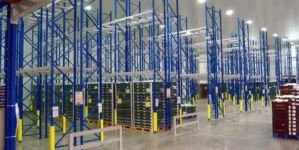-
Nutrivend selects Forterro’s Orderwise to support online expansion and streamline operations - April 11, 2025
-
ARROWXL LAUNCHES AMBITIOUS ZERO WASTE ROADMAP - April 8, 2025
-
THE BCMPA’S NEW CAMPAIGN DRIVES OUTSOURCING SUCCESS IN Q1 - April 7, 2025
-
BLACKOUT TECHNOLOGIES TARGETS TELEMATICS-INTEGRATED MOBILE DEVICE BLOCKING TO COMBAT SMARTPHONE DISTRACTION - April 1, 2025
-
Sparck Technologies awarded Royal designation - March 27, 2025
-
OpenADR Alliance announces first OpenADR 3.0 certified products with EVoke Systems, E.ON Energy and Universal Devices - March 25, 2025
-
Growing fulfilment and contract packer appoints new Managing Director - March 25, 2025
-
When is it time to invest in a WMS? Understanding the key trigger points - March 25, 2025
-
eCapital helps Vantage Recruitment on its journey to financial success - March 24, 2025
-
Hugo Beck Celebrates 70 Years of Packaging Innovation with Open House Events - March 20, 2025
Automation holds the key for staying relevant in an evolving online market.
By Mel Tymm, Industry Principal at Maginus
The boom in eCommerce has had a significant impact on our infrastructure and the logistics industry in the UK is now facing a new crisis; a lack of modern and fit for purpose warehousing space to manage supply and demand. Consumers are choosing to use brick-and-mortar stores as customer service hubs instead of retail spaces, and on top of this, their demands and expectations are growing with efficient and seamless same-day-delivery becoming the norm. To manage this change in consumer behaviour, major retailers are snapping up every inch of square footage available in an attempt to compete with eCommerce giants such as Amazon, and this is a very big reason for the shrinking warehousing landscape.
Retailers are therefore under pressure to rethink their warehouse and logistics strategies and make the best use of the space they have in order to meet the ever-growing demands of online shoppers. Utilising warehouse space in different ways will allow them to offer fast, reliable and cost-effective delivery in shrinking time frames to compete with the likes of Amazon, and develop a flexible space that will allow them to grow and develop their capabilities. Retailers have two options, they can either choose to move and split its operations into multiple smaller warehouses, in good proximity to the end consumer, or they can adapt its existing warehouse and find a new way to use the space – one of which is warehouse automation.
The robot touch
Over the past ten years, huge innovations and developments have been seen in warehouse automation that have helped businesses perfect operations and functions with the assistance of robots and other technologies. A great example is Ocado, which, in one of its warehouses, uses a combination of 1,110 robots that are supervised by only three maintenance engineers. A tailor-made grid system enables the robots to move around to collect groceries and feed them down to human workers who then pack the products. This new system has meant that Ocado is able to process 65,000 online orders per week. Ocado is even developing a robot that has the ability to pack orders to take its automated process one step further.
The grocery picking robots operate in an enclosed area, off-limits to employees and can pass within 5mm of one-another. Impressively, the robots can even take themselves off to be charged when the time is right – all of which allow the warehouse to work in the most time and space efficient way possible and fill those large amounts of online orders. Similarly, Amazon also uses bots to efficiently and automatically pick orders in its fulfilment centres. These robotic advancements allow more warehouse space to be utilised by enabling shelving to expand upwards, far out of the reach of humans, and for stock to be packed more compactly than in a conventional warehouse.
One small step to automation…
While automation has many desirable outcomes, it has traditionally been off-limits to smaller companies due to the initial cost and knowledge requirements. However, as even small and independent retailers are building websites with eCommerce capabilities there is a growing need for SMEs to invest in automation. While the cost of automation is sure to become more affordable in the coming years, employing a fleet of expensive robots isn’t the only way to benefit from automation. Many retailers still rely on a manual paper-based system for warehouse operations such as picking, sorting and re-stocking – which makes them vulnerable to human-error. As we know in the competitive eCommerce world, any small mistake in the delivery of goods could cost an
organisation any future business from affected customers. These companies could see large efficiency improvements by implementing small changes such as introducing mobile device picking technologies.
Connected mobile devices upload data onto a central system in real-time, and thus provide warehouse managers with complete visibility into all of the warehouse processes and current statuses of present tasks and products. Voice picking technology is another welcome development as it allows employees to work hands-free, improving efficiency and reducing the risk of repetitive strain injuries that many warehouse workers face. The real-time, connected nature of both forms of technology enables the system to predict when and where stock will need to be replenished and thus fixing potential problems before they occur. This also provides the management team the tools to more accurately analyse employee performance and make alterations to the team or an individual to help their operations run more smoothly where possible.
Employing warehouse automation technologies can allow retailers to become more efficient without increasing the space that it operates in. Automation removes the need to find new warehouses, while coping with ever-increasing consumer demands. Automation can be tailored to any business, small or large – as a large investment an enterprise could introduce bots into its warehouses or an SME can make simple changes such as implementing mobile and voice-enabled devices instead of using paper-based picking systems. The eCommerce market is evolving rapidly and so retailers must develop alongside it. In an era of instant gratification and consumers with a desire for same-day-delivery and excellent customer service, retailers must consider an automated approach to warehousing as part of its eCommerce strategy in order to stay relevant and competitive.
































